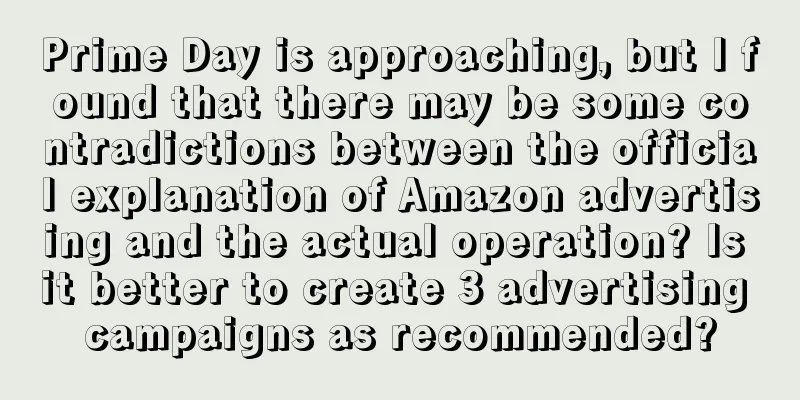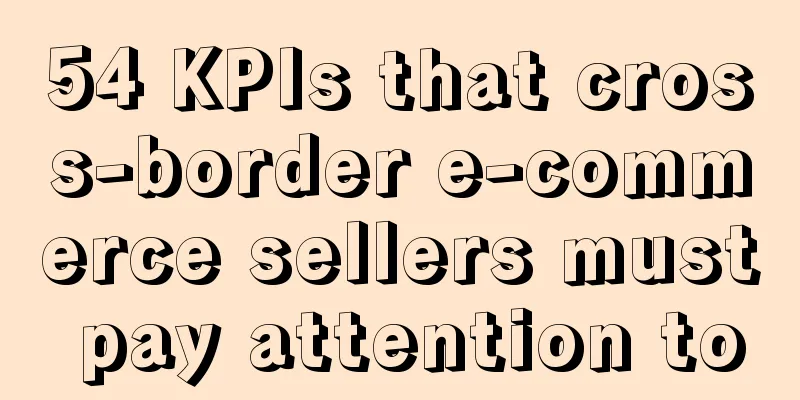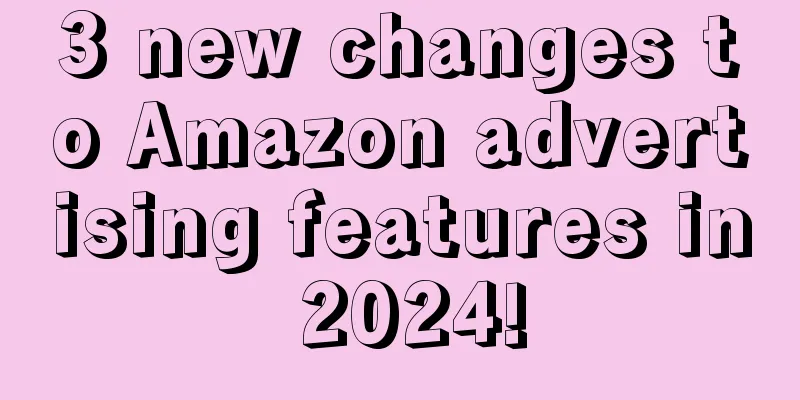|
What kind of advertising structure is most effective, like the Amazon advertising suggestions in the picture below?
Each operator has different habits in placing orders on Amazon.
In extreme cases, precise control is required, with one advertising campaign for each word, and often dozens or even hundreds of advertising campaigns. Even automatic advertising must be divided into 4 advertising interactions according to the matching method.
If you are a bit lazy, you can just run a few campaigns and put 10 to 20 words in each campaign. If you are a bit more creative, you can run a campaign for a single word/ASIN and group the rest of the words/ASINs into categories, and put a group of words in one campaign, usually less than 10. And so on...
How do you plan your advertising campaigns? Which kind of advertising method can achieve both product promotion and budget saving?
According to Amazon Advertising's recommendations, only three advertising campaigns are needed to achieve better results. Is this the actual situation? Will it result in some keywords not being able to use up any of the budget?
Is it true that the more keywords you place, the better? All relevant keywords should be advertised. After all, each ad space is a traffic entrance. If this word is not placed, does it mean that there will be a lack of advertising traffic for this word?
If the advertisement is only used to promote the keyword ranking, in fact, only a part of the keywords can promote the ranking of other keywords. The ranking trend of all keywords in a link is roughly the same, and it will not fail to rise just because the keyword is not advertised. Is this high efficiency and low budget?
"Wonderful Reply"
Lost Uncle - Drunkenly dancing in the Sutra Pavilion with half a scroll of books, sitting in the well and talking about the vastness of the world Agree with: Shenuin, Can you give me a coin, zwcnvl, Mango Xiangxiang, Sugar-fried Watermelon More » I look at this issue from two perspectives:
(1) Why does Amazon recommend avoiding duplication of advertising campaigns? I would venture to guess that there are two reasons. With the increasing number of boutique sellers, various strategies have emerged, and advertising has become more and more detailed and stacked.
On the one hand, many people’s ideas for advertising are unclear, which leads to many repeated matches (similar to the principle that Amazon does not recommend ST duplication), and many internal competitions for exposure occur. This has a poor effect and is more complicated to manage, which may affect the effect of continuous advertising.
Second, when there are more sellers stacking ads, a large amount of data will be generated, which will increase Amazon's data management and algorithm calculations. In essence, all placements are done by the Amazon system to help sellers place ads to different audiences, ad positions, time periods, etc. The logic of each placement requires system algorithm support. Repeated placements will increase the computational load of the algorithm. Therefore, based on efficiency considerations, Amazon is promoting this simplified approach. In fact, Amazon's algorithm may also have similar rules to filter out repeated placements at the front end to avoid computational burdens.
Based on this theory, accurate delivery based on customer search habits is more important. The more accurate the search terms, the shorter the search path (such as accurate matching for delivery and high weight), the easier it is to rank at the top, and the more accurate the crowd push will be.
And the stronger this loop is, the faster the reaction speed will be, which is equivalent to Amazon building a highway for you. To strengthen this loop, two conditions must be met: a good conversion rate and a large number of orders. With these two conditions (of course, there are other factors such as click-to-cart, which are ignored here), this loop will become stronger and stronger, and the path recommended by Amazon's algorithm will be shorter and the weight will be higher.
(2) You cannot adjust completely according to Amazon’s suggestions. Amazon has also made many suggestions, such as the suggested bid price. I believe that some people will follow the suggested bid price completely, but there are also some sellers who will not place orders based on the suggested bid price, and each of them has achieved good results.
The final result is the criterion for measurement. When building the advertising structure, if you want to simplify the operation model, such as the boutique operation model, you can refer to Amazon's recommendation model. After all, you don't want to make it so complicated; but in the boutique operation model, I think you should also try to avoid repeated advertising coverage and figure out the possible repeated coverage between keywords. In this case, the delivery will be more efficient.
Of course, you still have to do comparative testing yourself. After more comparisons, you will have a conclusion. There may be differences between different products because of differences in customer search habits. In the end, the actual results will be used as the direction and principle for advertising adjustments.
The above personal opinions are for reference only. Lost Uncle • Shenzhen One more thing to add: I personally think that duplication of advertising campaigns is not important. What is important is the duplication of keyword exposure. For example, if there are the same keywords in the phrase and the precision, part of the exposure range will overlap when there is no negation, which may cause internal competition; but if you negate the precision in the phrase, the overlapping range will become smaller. I think it is okay to place it if necessary. There are even some activities that use different bids to test the best situation, because different bids run in different positions, you can see which bid position is the most effective.
Weijia · Shaoxing The suggested bids for new products are nonsense. You won’t get any exposure if you bid according to the suggested bids. You need to bid at least 30%-50% higher to get some exposure.
Days are short and nights are long, and the tour is candlelight-lit -The day is short and the night is long, why not go out with a candle (sleep nm, wake up and have fun!) Endorsed by: SpikeNeverQuit , any123456 , Wickham , Aufine , Pencil Face More » What structure should be used to create an advertisement? I think it depends on the demand. Different demands will lead to different purposes of advertisements, and thus different structures.
Take a new product as an example <br>When you launch it, if you need to check if it is included in Amazon’s index, you need to turn on auto. After all, the principle of auto is to derive information based on Amazon’s index of links.
Next, new products have zero foundation. At this time, Amazon will have an expected conversion rate. The expected conversion rate is actually related to clicks, add-to-cart, etc. Then the advertisement can pay more attention to the click-through rate. The click-through rate for Amazon is based on words and ASINs.
Let's talk about keywords first. The most basic thing is that keywords should be compatible with products. Then you can look at the product orders. If you focus on core keywords, that is, precise matching. If it is convenient to control the budget, use a single word group. If it is a series, use broad if the words are widely distributed. And the keywords are related. If precise and broad work, they will naturally find related keywords for you to expose.
As for the ASIN selection, a single ASIN link is fine. If it is a multi-variant product, such as clothing, your color will affect clicks, and the size will affect the final conversion. In an extreme case, I choose the ASIN with the highest final transaction volume for delivery, so that all the exposure and clicks will be on this ASIN. This ASIN may be a hot-selling color and size, and the conversion performance is even higher. However, if this operation is out of stock or your opponent gives you a bad review on this ASIN, it will be very uncomfortable, so you can choose according to your own supply and risk resistance.
Speaking of budget, this depends on the promotion intensity your company can afford and the size of the words you choose. If you are a pure white hat and mainly promote with advertising, then the budget is related to your choice of keywords. If you want the keywords to quickly appear on the homepage, the exposure and clicks you buy with your budget must be in line with the level of the word.
For new products, I think these two types of ads are enough at the beginning, because at this time, your demand is to get Amazon to include them quickly. Then use auto to check the inclusion, and use broad and precise to frame a range to stimulate the inclusion. If you add some asin positioning, I think it is not appropriate. Associated traffic is a huge source of traffic, but how do you know what the attributes of the asin you are targeting are? If you match it, Amazon will include something for you at this time (when including it), which is not very controllable.
There must be a lot of details in it, and I am too lazy to type them here. What I mainly want to say is that advertising is a tool, and it can only bring value if this tool is used purposefully.
Is Amazon really bad? Operations have a ceiling, but cognition has no limit Agree with: komoribe, Nuanfengyihao, Mangoxiangxiang, Wickham, Aufine more » The competition situation of each company and product is different, and the purpose of advertising will also be different. Some of us only use big keywords, some only use second-order and third-order long-tail keywords, some do not advertise, and some only use audience advertising. If you have to say how to layout, I can only share our own advertising process.
Each of our products and each of our colleagues must confirm according to the small points listed below before promoting. We will never approve a single cent of advertising fee if we don’t think it through. We will also strictly follow this process for optimization during the launch period. Advertisements that do not meet the standards will be adjusted or closed in a timely manner. At least you must understand what kind of traffic your product is suitable for, what kind of ads can give you what kind of traffic, how much traffic you need every day, what words are suitable for the ad at the current stage, what position the goal is to promote it to, what is the purpose of this ad, is it to promote natural rankings, or to lose money on insurance policies, etc. If the purpose is not clear, don’t waste money on advertising, and it will also raise CPC in disguise.
1. Confirm the traffic framework
2. Confirm promotion phase goals
3. Confirm traffic demand
4. Confirm the appropriate keyword traffic
5. Confirm the appropriate product page traffic
6. Maximize target traffic
7. Staged target assessment
8. Phased optimization of advertising data model
9. Analysis of the ratio of natural traffic to advertising traffic
10. Secondary promotion target cycle AM L111 • Zhengzhou • 2024-06-05 16:59 Do these data need to be sorted out before the product orders are increased (before the new product is sold)? If so, where do these data come from? I have never seen such a company management model. It requires high operational quality, right? I really want to ask...
Nin iiiii • Guangzhou • 2024-06-05 18:02 [Every colleague must confirm according to the points listed below before doing promotion. If you don’t think clearly, we will never approve a penny of advertising fee.] I would like to ask if the points listed below can be understood in this way? Please advise! Thank you
1. Confirm the traffic framework---natural traffic/advertising traffic (automatic/manual)?
2. Confirm the goals of the promotion phase---what ranking/how many orders per day/what is the conversion rate/how many clicks/traffic are needed?
3. Confirm traffic demand--- expand traffic/precise traffic?
4. Confirm the appropriate keyword traffic--- exclude irrelevant/poorly relevant/poorly converted keywords
5. Confirm the right products and traffic---Choose the right competitive products and keywords
6. Maximize target traffic --- provide sufficient advertising budget? (Not sure)
7. Staged target assessment---Have the targets been achieved/which indicators have not been met?
8. Periodic optimization of the advertising data model --- Does the advertising part need to increase traffic/improve conversion rate?
9. Analysis of the proportion of natural traffic and advertising traffic --- whether it reaches 7-3/6-4
10. Secondary promotion target cycle
lea dtop • Guangdong • 2024-06-07 22:42 In my opinion, these 10 requirements of your company are indeed very detailed and should be a standardized process for a large-scale sales company. However, if it is a category that your company has not yet entered, and you list these 10 quantitative indicators when a new product is launched, even though there are many plug-ins on the market that can query competitor data for reference, but each listing and even each copy of the same advertisement under the same account have different genes. Does such a target really make sense?
Hans Huang • Shenzhen • 2024-06-08 20:34 1. Confirm the traffic framework - Use SP (hand-made ASIN) SB SBV SD advertising to create the framework
2. Confirm the promotion phase goals - some ads are aimed at promoting natural rankings, or at losing money to ensure volume.
3. Confirm traffic demand - what ads can give you what traffic, how much traffic do you need every day
4. Confirm the appropriate keyword traffic - Can you handle the traffic from a keyword that is too big? Will the CPC explode? (Cost-effectiveness)
5. Confirm the appropriate product page traffic - What ASINs can be hit?
6. Maximize target traffic - measure cost-effectiveness, increase or decrease bids, and run more ads
7. Staged target assessment - Have the goals of each advertisement been achieved? Close and adjust the advertisement. How many clicks should be achieved for the campaign under the framework, how many CTRs (click/impressions) should be achieved, what words should be changed when sales are reached, how long and how much sales can be achieved to reach what position, how much is the advertising CPC, how much is the ACOs, and what is the proportion of advertising orders.
8. Phased optimization of the advertising data model - I don’t understand, optimization framework? Can the host explain it?
9. Analysis of the ratio of natural traffic to advertising traffic
10. Secondary promotion target cycle
The general idea is to play with words, use appropriate and cost-effective words, and each advertisement must have its goal.
Is Amazon really that bad? • Shenzhen • 2024-06-13 11:57 I will take some time to sort out the breakdown of these 10 points and send them to everyone. @HansHuang is almost right. Some additions will be OK.
Hot sale machine -Cross -border e-commerce gatekeeper Agree from: any123456, Wickham, Yamada Panda, Xiaoliu 3Q, Tito123 More » As someone who has worked from Amazon advertising operations to co-entrepreneurship, let me say a few words.
1. Planning the structure of Amazon advertising campaigns
When creating Amazon advertising campaigns, different operators have different habits. Here are a few common strategies:
1. Extremely precise control: one campaign per keyword, or even divide automatic advertising into 4 campaigns according to matching methods. The advantage of this method is that the bid and budget for each keyword can be precisely controlled, but the disadvantage is that the management is complex and time-consuming.
2. Moderately lazy: Place 10-20 keywords in each campaign. This method simplifies management, but may result in some keywords not being able to eat the budget because the budget will be consumed by more popular keywords.
3. Strategic grouping: core keywords are grouped into one campaign for a single word/ASIN, and the remaining words/ASINs are grouped into categories, with one group of words (usually no more than 10) being placed in one campaign. This approach combines precise control with convenient management, and should be suitable for most sellers.
2. Amazon’s official recommendations and practical operations
Amazon officially recommends creating three campaigns. This approach helps simplify management and optimize results in theory, but in practice there may be the following problems:
1. Uneven budget allocation: If multiple keywords are placed in the same advertising campaign, popular keywords will grab most of the budget, resulting in other keywords having no budget at all.
2. Inconsistent results: The performance of different keywords varies greatly. It is difficult to accurately adjust bids and budgets when putting them in the same advertising campaign, which may lead to unsatisfactory overall results.
3. Advertising Strategy
1. Keyword coverage: The more keywords you place, the better. Although each ad space is a traffic entrance, not all keywords are worth placing. You need to select keywords with high conversion rates and good ROI for key placement based on data analysis.
2. Keyword ranking promotion: If the advertisement is mainly used to promote keyword ranking, selecting some high-potential words for key placement can indeed drive the ranking of other related words. This can not only improve efficiency, but also save budget.
IV. Specific Suggestions
1. Choose strategies based on product stages: In the new product stage, you can try extremely precise control strategies to accumulate data and understand which keywords work best. In the mature stage, you can switch to a strategic grouping method to improve management efficiency.
2. Regular optimization and adjustment: No matter which strategy you choose, you need to regularly check the data and optimize keywords and advertising activities. For poorly performing keywords, adjust the bid or suspend the delivery in time to ensure that every penny is spent wisely.
3. Use a combination of automatic and manual advertising: Use automatic advertising to discover new keywords, while using manual advertising to focus on high-potential words to achieve full coverage.
Finally, the optimization of Amazon advertising is a process of continuous trial, error and adjustment. I wish you achieve the ideal advertising effect. Amazon Calf • Shenzhen • 2024-06-05 15:34 Yes, everyone's situation is different, budget, product, promotion rhythm, etc., choose the advertising model that suits your current situation to achieve the desired effect. Without the support of a sponsor, you can reduce your advertising layout. Advertising is the pioneer of in-site promotion, but not the only one.
Cheese Snow Leopard -Come and make friends with the snow leopard! Agree with: saluki999, Laid-off Lao Foye, JasonHuang24, I am so awesome, Kong Yiji in a T-shirt More » Nowadays, many people think that advertising is too complicated, involving layout, weight, and a bunch of rigid terms. In fact, advertising is not as difficult as imagined.
Before creating an advertisement, you must think about one question: What is the most direct purpose of the advertisement?
Improve keyword position? Increase orders? Increase weight? None of these.
The most direct purpose of advertising is to let buyers see your products, that is, to bring in traffic. As for other conversions/orders/rankings/weights, they depend more on the product itself, which is related to product quality, price, main pictures, comments, etc., which I will not elaborate on. In short, running an advertisement is just to let buyers see your products.
Focusing on the analysis of “letting buyers see”, the following takes SP advertising as an example: the probability of seeing it in the first place on the homepage > searching in other locations > product page.
Back to how to layout and construct advertisements, it is nothing more than wanting buyers to see your products in a certain way and at a certain location. The way is the placement of keywords, and the location is bidding.
So how many campaigns do we need to create? One is fine, two is fine, three is fine, four is fine, or even a hundred is fine. It doesn’t matter.
So how many keywords should you put in each campaign? One is fine, two is fine, three is fine, four is fine, or a hundred is fine. It doesn’t matter.
We just need to make it clear that the purpose of advertising is to make the "desired keywords" appear in the "desired position". How to choose keywords? It's very simple. Brand analysis/Amazon search box/competing product titles, these three places can basically determine 90% of the keywords and their popularity.
How to adjust the position? It's even simpler, just adjust the bid. After the above is done, just wait for the test of the advertising effect. How to adjust the advertisement? Increase the budget for good ones, and change the position for bad ones.
Mr. Bafenbao - Amazon operations, Amazon team building, research on Amazon's latest promotion methods, and delve into the underlying logic of CPC advertising. Welcome to communicate Agree with: Wickham This is a very interesting question. There are three general directions in advertising architecture design:
1. Some people advocate the control of traffic, hoping that the traffic data of each keyword can be controlled by themselves. For example: exposure position, clicks and budget expenditure, etc. There will be a single group of words, and a fixed bid will be adopted. This gives rise to the problem of advertising optimization time cost. There is another question: Even if the control is completely in our hands, how much ability and confidence do you have to determine that the data and position you regulate are the best, and have you ensured that all traffic words are covered?
2. So another group of people optimized the advertising campaigns and placed advertisements to try to give more control to the Amazon system. Why? First of all, the design logic of the Amazon system is to put the product in front of the people who need it most at the lowest possible cost, so as to achieve conversion. The purpose of the system is the same as ours. This group of people will adopt the model of only lowering the bidding, while placing broad matches, relying on automatic advertising, or brand advertising, etc. Secondly, the system is sometimes dumber than people, and sometimes smarter than people. The core is that if the control is given to the system, our overall traffic costs will be reduced a lot.
3. The third direction of delivery is that the control is relatively in our own hands. Here is a new advertising architecture recommended. Article link: Advertising architecture design for the purpose of reducing CPC. This architecture makes use of advertising groups, taking an advertising campaign as a unit, and uses advertising groups to transfer traffic. On the one hand, it solves the problem of different weights of advertising campaigns leading to failure of traffic transfer. On the other hand, advertising campaigns are streamlined, budgets are more controllable, and the time cost of advertising campaign optimization is greatly reduced.
R123321 Agree from: HansHuang Let me tell you the underlying logic of Amazon's suggestion.
Most ads are charged based on clicks. Amazon can only expose you, but not directly give you clicks. So if you create the same or similar ads, Amazon can only expose you in order. Even if you bid at different prices, the one with the higher bid will be given priority. This will result in the advertising budget not being spent so quickly. Of course, your clicks will definitely be affected. This is what Amazon said greatly affects the advertising effect.
But as long as you create different advertising methods, Amazon can expose you in different positions under many words, so your advertising fees will be consumed quickly.
So Amazon's suggestions are made for your advertising money, not for you. You can analyze Amazon's advertising suggestions and find that most of them are designed to make you spend more on advertising.
hanshanxue Agree with: EdstingZa, any123456, Wickham, Memories of a Seaside Town, weixin76881 More » For many years, there has been one manual ad and one automatic ad. Different matching methods are used in manual ads.
I have also tried to separate the precise keywords, but found that it is useless. Under the same conditions (ASIN, bidding, bidding+), there will be no difference in the exposure, click-through rate and conversion of keywords. It is only useful in one scenario, such as when the precise keyword is a big keyword with good traffic conversion. Separating it out is more conducive to controlling the budget and the bid+ price increase.
By the way, for the same word, there will be no difference in ad placement under exact matching and broad matching.
Laid-off Mr. Buddha - retirement in progress Agree with: Another Autumn, Letter in a Hurry, I'm Not a Scumbag, Wickham Take Mattress, a headline category in the cross-border circle, as an example.
We looked at the top 25 competitors’ advertising data for 3 months (US sellers). There were no campaigns targeting only one keyword. Each campaign targeted at least 5 keywords and at most 50 keywords. There were 44 campaigns in total, including one automatic one, which delivered a total of 755 keywords.
I observed their activity naming method and tested the ones generated by two ad hosting software. All activity logics are one activity, one set of ASINs, one set of words, and covering three matching types at the same time. It is simple and crude. I am not a scumbag • Guangzhou • 2024-06-05 11:57 Is advertising hosting reliable? Our company recently quoted this
Laid-off Lao Foye • Zhejiang • 2024-06-05 13:50 I have only used Apollo's advertising hosting software. At that time, I was responsible for the category of women's shoes. In fact, I did not promote any products because of the use of the software; but through the software, I was able to quickly manage more advertising activities within a limited budget. Later, because the advertising budget we could invest was getting smaller and smaller, I cancelled the renewal after using it for a year.
Laid-off Lao Foye • Zhejiang • 2024-06-06 14:44 @Wickham : From the perspective of the commonly believed advertising weight, it will drag down the weight of the stable words in this ad group;
ha nshanxue • Ningbo • 2024-06-06 22:02 @下裁老佛爷: Is the so-called advertising weight a mystery? If a word is not exposed or converted in this advertising campaign, will the exposure, conversion and ad position be different in another advertising campaign with the same bidding?
|










